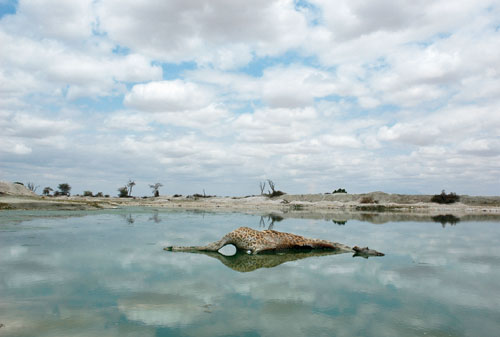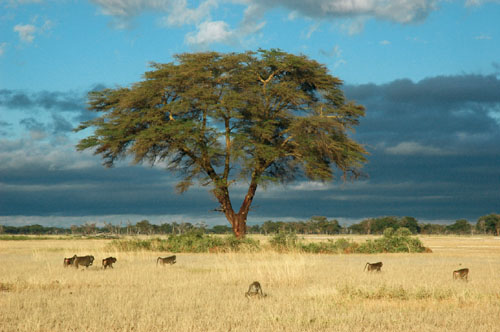A Limited-Edition Report from the Field
By Anna Lena Phillips
From an evolutionary biologist’s year in Kenya’s Amboseli basin, both research and a fine-press book are emerging
From an evolutionary biologist’s year in Kenya’s Amboseli basin, both research and a fine-press book are emerging

DOI: 10.1511/2012.96.202
Two thousand nine was a hard year for the inhabitants of Kenya’s Amboseli basin. Courtney Fitzpatrick, a Ph.D. candidate in evolutionary biology at Duke University, was there to see it. During a year-long Fulbright fellowship with the Amboseli Baboon Research Project (ABRP) in 2009 and 2010, Fitzpatrick was present for the worst drought the country had experienced in decades. She witnessed the devastating results for local people and for wildlife populations.

To connect with friends and family in the United States, and to help cope with the scenes unfolding before her, Fitzpatrick began to write lyric essays, which she painstakingly posted to her blog over the field station’s spotty Internet connection. A single piece could take an afternoon to upload—a short time in the world of writing, but an age in the world of the Internet. The making of these essays, like the letters scientist-explorers wrote in earlier times, spans physical distance and challenges our conceptions of time and effort.
On her return to the United States, Fitzpatrick decided that she wanted to present a formal record of her experience in Amboseli. The longing for her North Carolina community that she experienced in Kenya led her to collaborate with Dave Wofford of Horse & Buggy Press, a letterpress printing and design studio in Durham, North Carolina, to create Maji Moto: Dispatches from a Drought, a limited-edition fine-art book that will be released in April. (Maji Moto is the name of a watering hole in Amboseli; the Swahili phrase means “hot water.”)
Fitzpatrick’s essays form the text of the book. It also features photography—a medium that is essential to her research. During her field work, Fitzpatrick studied the evolution of exaggerated estrus swellings in female baboons. In an effort to find out whether this trait evolved as a consequence of sexual selection pressure, she measured the swellings of female baboons in Amboseli and examined variation in their size. Her main tool in this effort was the camera.
Susan Alberts is codirector of the ABRP and professor of biology at Duke University. She serves as Fitzpatrick’s adviser. “There’s of course a long tradition of using photos to analyze morphology,” she says, “but what’s less common, because it’s harder, is using photos to measure the size of a morphological feature.” She notes that this technique has been used to measure the size of elephants and polar bears. “A little bit of error in measuring an object that’s several meters high is not that big a deal,” she notes, “whereas a little bit of error in measuring an object that’s maybe 8 to 10 centimeters across is huge.” To measure the swellings, Fitzpatrick needed a very precise method. She bought a Photoscale II caliper that, when attached to a camera lens, measures the distance to the baboon being photographed. This, in turn, allowed her to estimate the size of the estrus swelling from a digital image. “Courtney collected the largest dataset ever accumulated on sexual swelling size in nonhuman primates, and she did so in a wild primate population,” says Alberts. The results from Fitzpatrick’s research in Kenya will form the basis of her dissertation. Fitzpatrick plans to work on theoretical models of evolution by sexual selection during a postdoctoral position at the National Evolutionary Synthesis Center (NESCent) beginning in January 2013.

Fitzpatrick’s undergraduate degree is in studio art, so it made sense for her to use the camera in her research. She carried it during her field work and could not resist turning its lens on the landscape and its inhabitants. As the drought wore on, she documented its effects in photographs and in text. In an entry dated September 2009, she writes:
Cows, calves, wildebeest, elephants, buffalo. They are dying in droves. Forget sleeping groves and water holes, you could map this place by its dying and dead. They are pushpins marking the intersection of space and time.
In Maji Moto, the essays are rendered on clean, wide pages in an elegant font, more in keeping with earlier traditions of reportage than with the Internet. They are complemented by reproductions of Fitzpatrick’s photographs; the book is hand bound in letterpress-printed covers. The limited edition recalls John James Audubon’s bird books—and as Audubon did, Fitzpatrick is selling copies of the book in advance to offset the costs of its production. There are a few differences in approach: Audubon hunted animals and sold their skins to further support his publication; Fitzpatrick has launched a Kickstarter campaign.
But these strategies may be more similar than they appear. Audubon catered to the desires of people in his time; furs were a marker of social class. One present-day luxury, and a marker of social identity, is supporting artists in doing their work—as Kickstarter’s popularity attests. The book, and a collection of large broadsides with letterpress printed text and giclée printed photographs, will be on view at an exhibition in Horse & Buggy’s gallery in downtown Durham, from April 12 to June 30, 2012.
It’s easy to recall earlier examples of this sort of project, such as Maria Sibylla Merian’s 17th-century paintings of the insects of Suriname, from a time when disciplines were less specialized and scientific discourse less codified. The standardization of science in the 1800s improved the communication of research, but this process also narrowed the field of who could present science and how it was presented, minimizing the naturalists’ reports that had so entranced the public. Scientists’ desire to report directly from the field persists—in 2011, for instance, Harvard University Press published Field Notes on Science and Nature, a collection of working scientists’ field notes and essays about them. Memoirs of field work and literary nonfiction about the natural world are published fairly regularly, and the Internet’s now-clichéd democratization of publishing has encouraged more people to engage in writing. But projects that present field experience through fine art and writing are harder to find.
Fitzpatrick considers herself a beneficiary of the tradition of naturalists and field biologists. But visual art has been an equally important influence. “I’ve always been interested in animal behavior,” she says, “but it was actually through my undergraduate art classes that I had that stereotypical experience of meeting one’s own intellect. Having been trained as an artist and trained to think like an artist—even though it wasn’t a lot of training—has hugely informed the way I approach science.”
Alberts has supported Fitzpatrick in her creative work. “Creativity is vitally important to doing science,” Alberts says. “Scientists know this, but the public doesn’t always. If a scientist is evaluating the work of another scientist, they’ll ask how creative they are in their work.”
Click "American Scientist" to access home page
American Scientist Comments and Discussion
To discuss our articles or comment on them, please share them and tag American Scientist on social media platforms. Here are links to our profiles on Twitter, Facebook, and LinkedIn.
If we re-share your post, we will moderate comments/discussion following our comments policy.